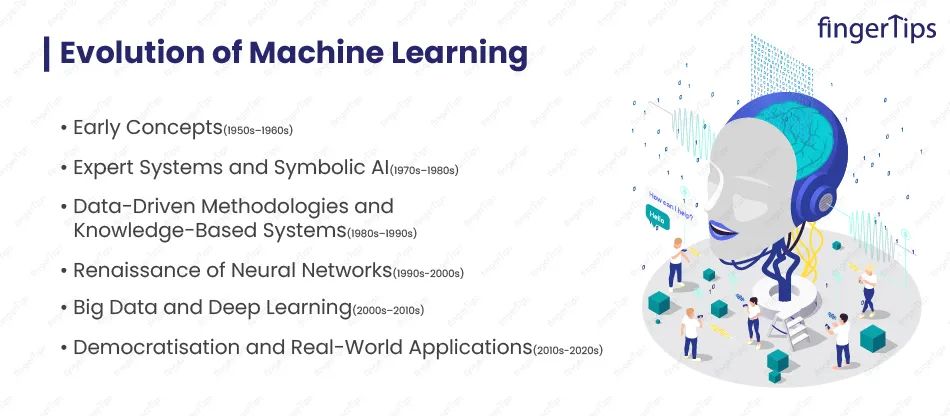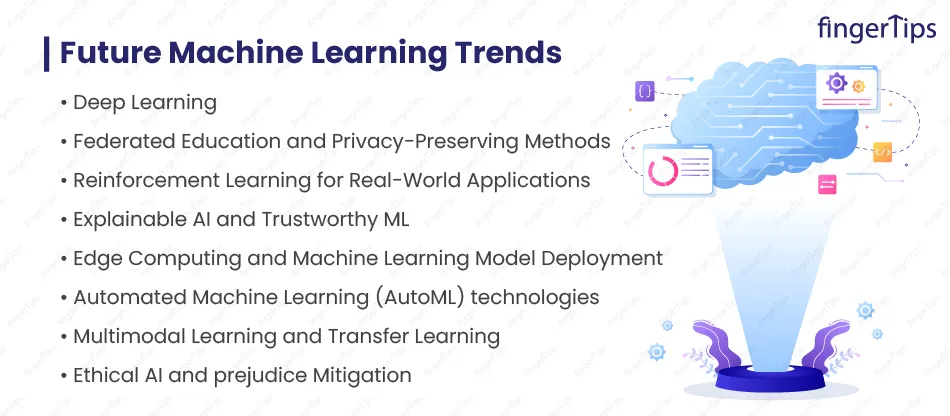Machine learning is one of the most trending topics for the coming years. By listening to different job opportunities in the field of machine learning, it is obvious to get curious about machine learning's future. But, before jumping to see the future of data science and machine learning, you need to know what's machine learning.
In this blog, not only we'll see what is machine learning but also other technical and related terms with machine learning. Let's start with basic and begin with seeing machine learning vs. artificial intelligence vs. deep learning.
Machine Learning vs. Artificial Intelligence vs. Deep Learning
Technology and automation advances are driven by three interconnected fields: machine learning, artificial intelligence, and deep learning. Although they have certain commonalities, their methods and applications are different.
Machine learning (ML), a branch of artificial intelligence (AI), is the study of statistical models and algorithms that allow computers to learn from data and make judgments or predictions based on that data without having to be explicitly programmed for each task. The main objective of ML is to enable machines to learn from experience and increase their performance on a given activity, much like people do.
On the other hand, the creation of systems that can carry out activities that ordinarily need human intelligence is covered under the broader field of artificial intelligence (AI). AI strives to develop machines that can reason, solve problems, learn, and make judgments similarly to humans. Data-driven AI, on the other hand, uses ML techniques to identify patterns in data and make judgments based on the discovered information.
Artificial neural networks are used in deep learning, a specialized area of machine learning, to model and analyze complicated patterns in vast volumes of data. These neural networks may process information in layers, with each layer isolating higher-level representations from the incoming data since they are created to replicate the structure and operation of the human brain.
So this was the basic machine learning vs. artificial intelligence vs. deep learning. Now, it's time to get back in time and see the evolution of machine learning.
Evolution of Machine Learning

Machine Learning (ML) has undergone a remarkable transformation as a result of improvements in computing power, the accessibility of large datasets, and advances in algorithmic research. The following significant stages might be used to summarize the journey:
1. Early Concepts (1950s–1960s): The 1950s and 1960s saw the introduction of the first artificial neural networks and the invention of the perception algorithm, which provided the groundwork for modern machine learning. The idea of "learning machines" and fundamental pattern recognition tasks were investigated early on.
2. Expert Systems and Symbolic AI (1970s–1980s): During this time, the emphasis changed to rule-based systems and Symbolic AI, which depended on explicit knowledge representation and rule-based reasoning. Although they were designed for specialized tasks, expert systems had trouble processing complex and ambiguous data.
3. Data-Driven Methodologies and Knowledge-Based Systems (1980s–1990s): Knowledge-based systems were developed in the 1980s and 1990s by fusing statistical learning with rule-based reasoning. Techniques including decision trees, Bayesian networks, and support vector machines were investigated by researchers.
4. renaissance of Neural Networks (1990s-2000s): With improvements in backpropagation and better topologies, neural networks saw a renaissance in the 1990s. Their widespread application, however, was constrained by processing limitations and the "AI winter."
5. Big Data and Deep Learning (2000s–2010s): The 2000s saw the emergence of big data, which made it possible to gather and store enormous datasets. Deep learning became a potent tool in the 2010s thanks to technological developments, including the introduction of graphics processing units (GPUs) and breakthroughs in computing. In image identification, natural language processing, and other challenging tasks, deep learning models have produced ground-breaking results.
6. Democratization and Real-World Applications (the 2010s-2020s): The democratization of ML occurred in the 2010s with the creation of approachable ML platforms and libraries. Applications for ML emerged in several industries, including marketing, banking, healthcare, and autonomous systems.
Today, machine learning (ML) is widely used to power several services and apps that affect our daily life. The discipline is still developing, propelled by ongoing research and advancements that will eventually give rise to more advanced and intelligent systems.
Machine Learning Job Scope and Salary Trends
The salary trend in India depends upon multiple factors. But let's look at the average salary scope for the field.
Fresh graduates with the necessary skills and knowledge can anticipate earning between 4 and 5 lakhs for entry-level roles in machine learning, such as Machine Learning Engineer or Data Scientist.
Salary levels for those with 2 to 5 years of machine learning experience might range from 8 to 15 lakhs per year. Professionals' compensation may rise in line with their practical experience and demonstration of mastery of managing ML projects.
Salary ranges for machine learning professionals with more than five years of expertise range from 15 lakhs to 30 lakhs or even more annually. Professionals at this level are anticipated to have in-depth knowledge of ML techniques, substantial project experience, and the capacity to lead successful ML implementations.
Now, you already know about the high scope of machine learning. Here's how you can build your career in a step-by-step guide. 
Learn The Right Skill
When you want to get the right opportunity for your career, the key is to learn the right skill and increase your knowledge in the right field. Get enrolled course and get hold of the required knowledge.
Internship
If you're fresher with zero work experience and knowledge in the field, it would be a wise choice to start interning in the right field. This way, you'll gain practical exposure along with your learning. This will be your stepping stone to getting the right and high-paying machine engineering job in the future.
Keep an Eye on Trends
Machine learning is a developing field, and multiple trends come in the field, which we'll see further in the topic. So, make sure to stay updated with the trends so that recruiters know that you're well knowledgeable about the industry and field. Don't miss out on this opportunity to enhance your skills and take your career to the next level.
Become a Certified Data Scientist-Enroll Now
These are some of the ways that can help you get your dream job. Now, it's time to see the last topic of the guide, which is future machine learning trends.
Future Machine Learning Trends

Several trends are anticipated to influence the future of the machine learning (ML) sector. The following are some major themes that are anticipated to have an impact on the advancement and use of ML in the upcoming years:
1. Deep Learning will continue to make breakthroughs, which has been a key factor in machine learning's recent success. To handle increasingly more complicated and varied datasets, researchers will concentrate on enhancing deep neural network topologies, regularization strategies, and training approaches.
2. Federated Education and Privacy-Preserving Methods: Federated learning and other privacy-preserving strategies will become more popular as worries about data privacy increase. Data is kept on users' devices rather than being centralized in a server thanks to federated learning, which enables ML models to be trained on decentralized data sources.
3. Reinforcement Learning for Real-World Applications: Reinforcement Learning (RL) will find increased use in real-world settings, such as supply chain optimization, robots, and autonomous cars. To address uncertainty and real-time decision-making in dynamic contexts, RL algorithms will be improved.
5. Explainable AI and Trustworthy ML: Research into explainable AI will be fueled by the demand for accountability and transparency in ML models. To better understand how decisions are made and to guarantee that ML systems are more dependable and equitable, efforts will be made to construct interpretable models.
6. Edge Computing and Machine Learning Model Deployment: As IoT devices proliferate, ML models will be set up at the network's edge, obviating the requirement for centralized cloud processing. By processing data locally, edge computing will speed up inference and address privacy issues.
7. Automated Machine Learning (AutoML) technologies will proliferate, making machine learning (ML) more approachable to non-experts and democratizing ML. By automating model selection, hyperparameter tuning, and feature engineering, these tools will lower the entry barrier in the field.
8. Multi-modal Learning and Transfer Learning: In multi-modal learning, researchers will investigate methods for fusing data from many sources, such as text, images, and audio. To improve performance on other tasks or domains, transfer learning will also be expanded.
10. Ethical AI and prejudice Mitigation: There will be more emphasis on efforts to address prejudice and ethical issues in ML models. The development of approaches to identify and address biases in data and algorithms will be a joint effort between researchers and practitioners.
Together, these trends portend an exciting future for machine learning, one in which technology will be instrumental in tackling challenging issues, spurring innovation, and reshaping numerous industries.
Conclusion
Machine learning has a bright and revolutionary future. Various industries will change thanks to developments in explainable AI, federated learning, and deep learning. Incorporating ML with other fields of study will enable practical applications like robotics and autonomous systems. AutoML will democratize ML and make it more approachable for laypeople. Complex problems will be addressed by ethical AI and quantum machine learning. Responsible growth and ethical considerations will be essential for determining a positive and significant future for machine learning as the subject continues to advance.







